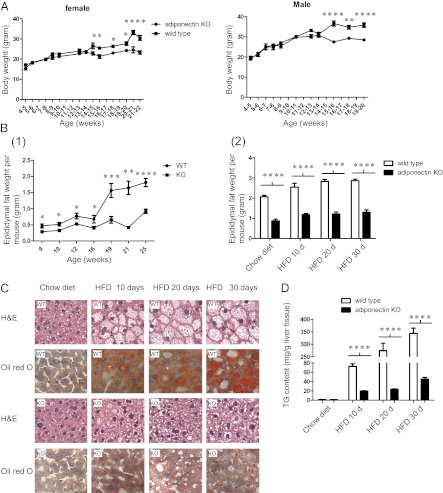Fig. 5.
Adiponectin KO mice showed reduced body weight after 15–16 wk of age and possessed smaller epididymal fat pads compared with WT mice. When fed a HFD for 10, 20, and 30 d, KO mice exhibited a dramatically reduced fat accumulation in their livers. Results were presented as mean ± SEM. *0.01 < P < 0.05; **0.001 < P < 0.01; ***P < 0.001; ****P < 0.0001. (A) Comparison of body weight (grams) between female and male WT (■) and adiponectin KO (●) mice fed a chow diet at the indicated age (n = 6∼15). (B Left) Epididymal fat pad weights of WT and adiponectin KO male mice (age 9∼25 wk) maintained on a normal chow diet (n = 3∼9). (Right) Epididymal fat pad weight of WT and adiponectin KO male mice (age 18∼20 wk) following a control (chow diet) and a HFD for 10, 20, or 30 d (n = 5∼7). (C) H&E and Oil Red O staining of livers of male WT and adiponectin KO mice (age 18–20 wk), after being fed a control diet or a HFD for 10, 20, and 30 d. (D) Effects of a control and a HFD for 10, 20, and 30 d on liver triglyceride levels (TG) in male WT and KO mice (n = 5∼7).

